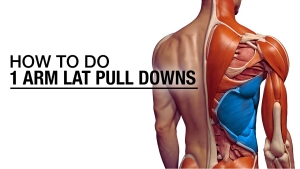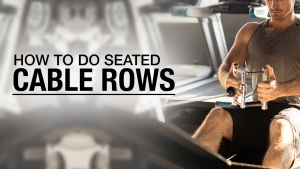
CABLE BACK WORKOUTS
It’s easy to get caught up in the gym classics—the trusty barbells and dumbbells. There’s no denying their power, simplicity, and overall effectiveness.
And trendy, fancy equipment might get your attention for a bit, but right there, often overlooked in the corner, is the cable machine.
Free weights are great, we know that. But the cable station is packing just as much punch—if not more than all the other gym equipment.
If you want a versatile back workout that hits every angle, challenges muscle recruitment patterns, and provides consistent tension, then you can’t ignore the benefits of cable back workouts.
Think about targeting those hard-to-reach lower lat muscles or getting that sharp V-taper. Cable machine workouts could be the game-changer you’ve been missing.
Let’s break down the techniques behind my go-to cable back exercises and see how they can elevate your cable machine training.
Time to give cables the spotlight they deserve!
MUSCLE GROUPS OF THE BACK
For a killer cable training routine, we’re targeting the upper, mid, and lower back muscles fibers.
But before you learn the moves, you need to understand how the muscle functions.
This will help you build a strong mind-to-muscle connection, ensuring a better contraction as you move through these back exercises.
As always, I’m breaking out the Muscle Markers to highlight the major muscle groups of the back.
THE LATS

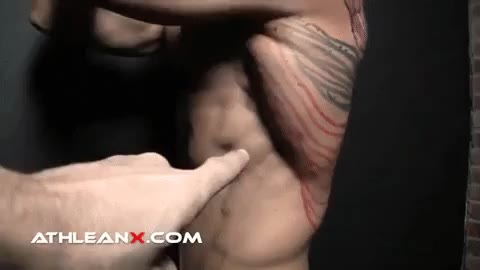
The lats – or latissimus dorsi muscles, if we’re getting technical – are some of the largest muscles in your back, spanning a good portion of your lower and mid-back.
These primary muscles start from your spine and fan out, attaching to the side of your upper arm bone (the humerus) and creating a “wing-like” appearance when displayed.
What do the lats do?
- Shoulder Extension: When you bring your arm down from a raised position or push it backward – think of the motion during a pull-up or when you’re swimming – that’s your lats at work.
- Shoulder Adduction: They help to bring your arm closer to the side of your body. If you flap your arms like a bird, it’s your lats that help pull them down.
- Internal Rotation of the Shoulder: When you turn your arms inward, your lats play a role there too.
Two of the most popular lat-focused back exercises include the Lat Pulldown and Dumbbell Pullover. These are great exercises, but the loading conditions will depend on your experience.
For all the exercises I discuss, new lifters should start out light and listen to your body before increasing the weight load. Experienced lifters will be able to start with more weight but should follow the same rule.
UPPER AND LOWER TRAPS

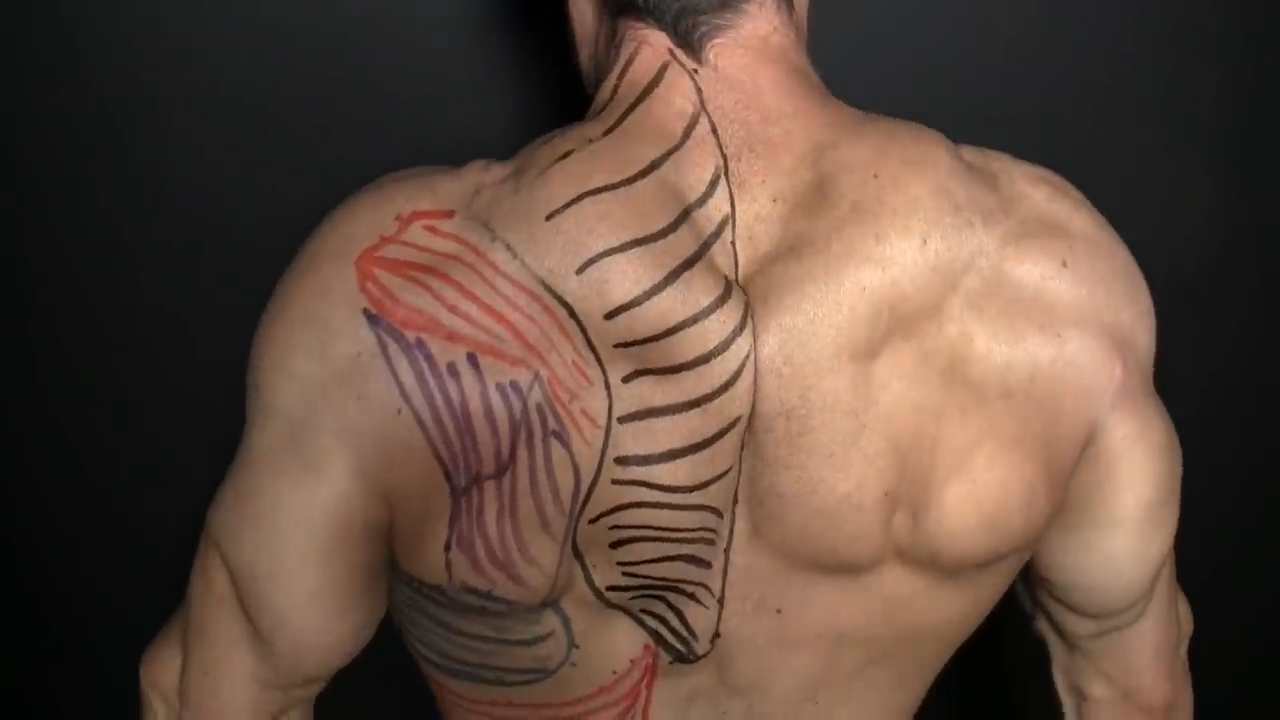
When we’re diving into the muscles of the back, we can’t overlook the trapezius muscles, or as most of us know them, the “traps.”
You can imagine the traps like a diamond draped over your upper back.
The upper traps? They start right at the base of your skull, stretch down your neck, and hook onto that collarbone. When you shrug those shoulders or raise your arms high overhead, that’s them in action.
Moving further down, we’ve got the middle traps and the lower traps. They kick off from the mid-spine and anchor down on the shoulder blade.
They’re engaged when you’re pushing your shoulder blades down or lifting your arms up overhead.
LOW BACK / ERECTOR SPINAE


Picture this: your spine acts as the central pillar of your back, and right next to it, running vertically, are the erector spinae muscles.
These aren’t just a single muscle; they’re a group of deep muscles and tendons that stretch from the base of your skull all the way down to your lower back and sacrum.
When we talk about their function, the erector spinae are pivotal.
What is the function of the erector spinae?
- Spinal Extension: – Every time you stand up from being bent over or lift your head to gaze upwards, these muscles are at work.
- Protect the Vertebrae: Think about doing Deadlifts at the gym. It’s the erector spinae ensuring you maintain that essential neutral spine, providing protection to your vertebrae.
- Lateral Flexion: These muscles are also involved in lateral flexion, which is when you bend your trunk to the side.
- Rotational Movement: They contribute to the rotational movements of the spine.
ROTATOR CUFF


When we talk about the rotator cuff, we’re referring to a group of four deep shoulder muscles that collaborate to keep our arm bone, the humerus, securely in the socket of the scapula.
What are the muscles of the rotator cuff?
- Supraspinatus
- Infraspinatus
- Teres minor
For our focus on the backside, the spotlight is on the infraspinatus and the teres minor, both of which reside on the back part of the scapula, that flat bone you feel in your upper back.
What are the functions of the rotator cuff muscles?
- External Rotation: Think about the motion of winding up for a baseball pitch; that’s heavily reliant on the infraspinatus and teres minor.
- Stabilization: During almost every shoulder movement—whether it’s lifting, pushing, or pulling—these muscles act as stabilizers, ensuring the humerus moves seamlessly within its socket.
Face Pulls are one of my favorite exercises for the rotator cuff.
TERES MAJOR


If you’ve ever taken a look at the backside of your shoulder, you’ve got this small, yet mighty muscle called the teres major.
Think of it as the “little helper” to the latissimus dorsi.
To truly visualize where the teres major sits, start by finding your armpit. From there, move towards your spine and upwards a tad.
That thick band you feel? That’s our guy, the teres major!
What are the functions of the teres major?
- Shoulder Extension: Ever pull something close to you from the front? Like, say, during a rowing exercise? That’s your teres major helping out in driving that motion.
- Internal Rotation of the Arm: If you’ve ever done a dumbbell arm curl and then tried to pour out the contents by rotating your arm inwards, that’s the teres major hard at work!
- Adduction: Try bringing your arm down to your side from an elevated position, almost like you’re trying to tuck it into your pocket (without the bend, of course). The teres major is one of those muscles that helps in that adduction.
The Dumbbell Row is an exercise that targets the teres major, but since we’re focusing on cables and not a pair of dumbbells, you’ll be performing exercises like the Seated Cable Row.
BEST CABLE BACK WORKOUT
Now that you have wrapped up with your anatomy lesson for your back muscles, it’s time to learn about the exercises for the best cable back workout.
As far as the order of these cable back exercises is concerned, I’m going to start with the largest muscles and move down to the smaller ones.
Let’s kick things off with one of the cable machine exercises you’re most likely familiar with – but you might not know the proper form.
TRADITIONAL LAT PULLDOWNS

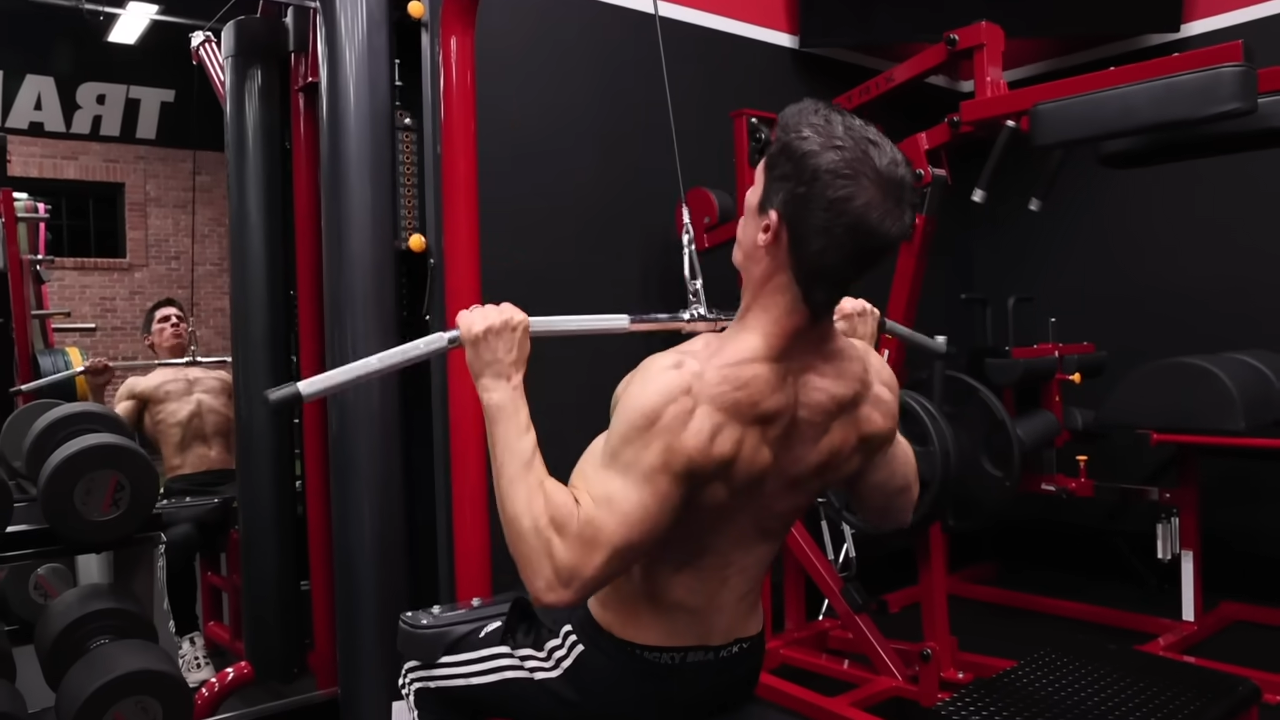
HOW TO DO LAT PULLDOWNS:
- First thing, setup: grab the bar with an overhand grip (pronated grip) at shoulder-width or just outside of shoulder-width.
- Engage your core, tuck your pelvis slightly, and maintain a little arch in your lower back, with your chest up.
- As you pull down, envision driving your elbows down to your hip pockets. This mental cue ensures we’re targeting those lats effectively.
- At the bottom, your elbows should be in line with your ribcage, giving those lats a solid squeeze.
- Resist the weight on the way up to the starting position.
WHAT MAKES IT EFFECTIVE: Many tend to make the mistake of simply yanking down on the bar, but the power and focus should be on driving those elbows down and engaging the lats. By retracting the shoulder blades, you can focus all of the effort on the lats, which is where you want it!
ROM PULLDOWNS / REVERSE GRIP LAT PULLDOWNS


HOW TO DO ROM PULLDOWNS / REVERSE GRIP LAT PULLDOWNS:
- First things first: you’ll need a cable apparatus equipped with a straight bar cable attachment. Opt for a supinated grip (underhand grip) with your hands roughly shoulder-width apart.
- Engage your core throughout this exercise, thinking of it as the foundational support for the movement.
- Now, with your arms fully extended overhead, you should feel a slight stretch in your lats. Begin by retracting the shoulder blades.
- Pull the bar down and visualize your elbows trying to find their way into your pockets.
- Pause at the bottom of the movement and slowly return to the starting position.
WHAT MAKES IT EFFECTIVE: Many tend to make the mistake of simply yanking down on the bar, but the power and focus should be on driving those elbows down and engaging the lats. By retracting the shoulder blades, you can focus all of the effort on the lats, which is where you want it!
SEATED CABLE ROWS

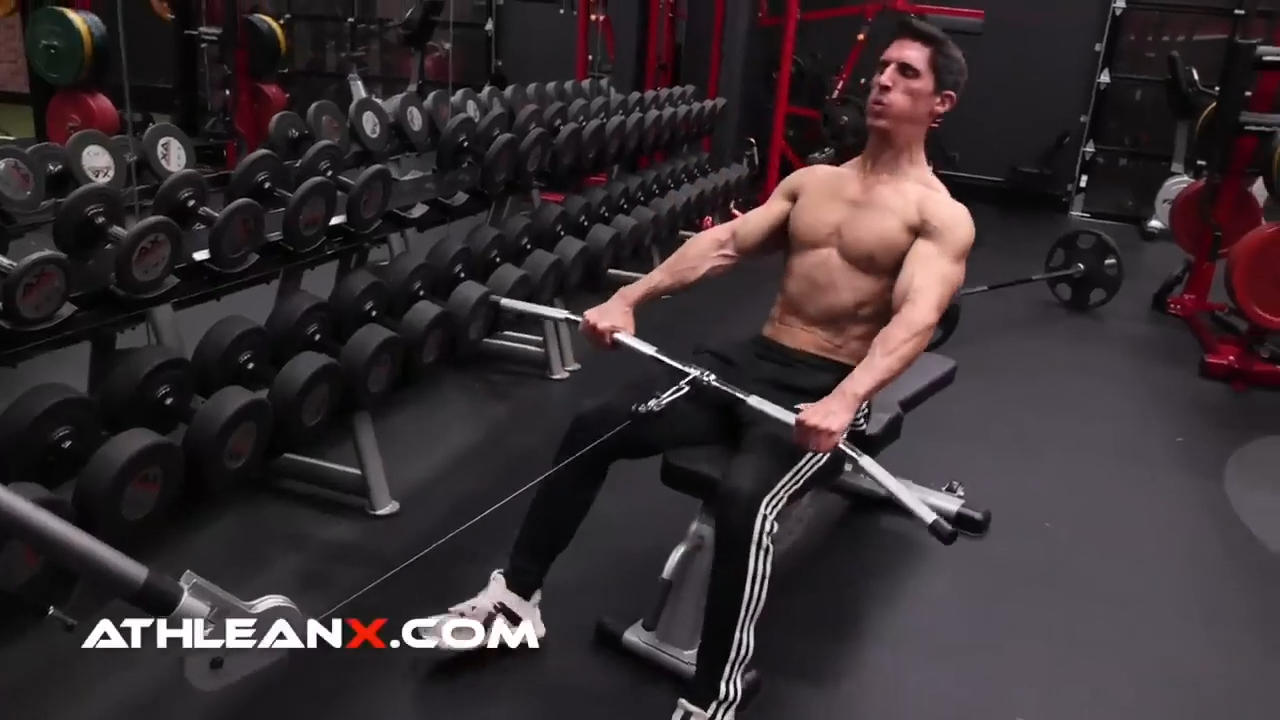
HOW TO DO SEATED CABLE ROWS:
- First off, set yourself up in a seated position at the cable pulley rowing machine bench with your feet flat on the platform. Grab the cable attachment that you prefer. It could be the V-handle, straight bar, or cable rope attachment.
- Sit with your chest up and your shoulders back and down – don’t let them round forward. This isn’t just for aesthetics. It’s about putting your scapula in a stable position to pull and engage the muscles properly.
- Take a firm grip on the handle. As you pull, you want to think about engaging the back muscles and driving your elbows back, not just pulling the handle towards you.
- Initiate the movement by retracting your scapula. Squeeze the shoulder blades together as you drive those elbows back. Think about trying to hold a pencil between your shoulder blades. Pull the handle towards the lower part of your ribs.
- On the way back out, don’t just let the weight stack drop. Resist it. This eccentric phase of the exercise is just as important as the pull.
WHAT MAKES IT EFFECTIVE: One of the great compound exercises for the back, the cable rowing machine forces you to keep your torso stationary while retracting the shoulder blades and engaging the midback with constant tension. It hits the same muscle groups as the Barbell Row. The Single-Arm Cable Row and the Wide-Grip Cable Row are variations I’d highly recommend trying as well.
STRAIGHT ARM PUSHDOWNS

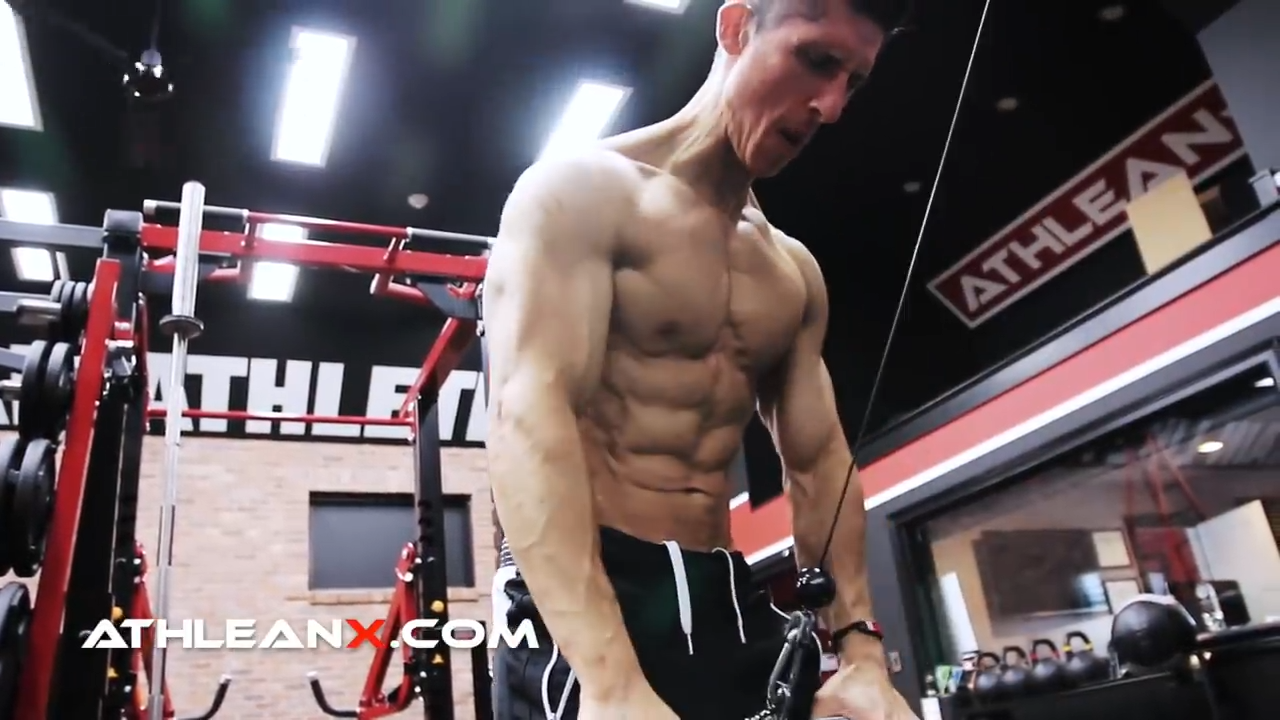
HOW TO DO STRAIGHT ARM PUSHDOWNS:
- Start by positioning yourself at a cable machine with a high pulley, attaching either a straight bar or rope attachment.
- Engage your core and keep your chest elevated.
- With an overhand grip (pronated hand position) and a slight bend in your elbows, focus on pushing the bar or rope downwards using only your lats, all while maintaining straight arms and keeping your torso position consistent.
- Think of creating a strong mind-muscle connection, visualizing your lats contracting, and imagine your shoulder blades moving closer to your waist.
- As you return the cable stacks back to the starting position, do so with a controlled motion to optimize muscle tension.
WHAT MAKES IT EFFECTIVE: Straight Arm Pushdowns improve straight arm scapular strength, which will benefit shoulder blade stability.
ALTERNATING HIGH CABLE ROW


HOW TO DO ALTERNATING HIGH CABLE ROWS:
- Position yourself at a cable station with the cable pulley attachments set high up. Grasp the cable pulleys securely with your left hand, keeping your feet shoulder-width apart and a slight bend in your knees for stability.
- With your arm fully extended, pull the cable handle towards your torso, making sure to draw your elbow back and twist your upper body. As you do this, engage your lats, and focus on the mind-muscle connection to ensure maximum muscle activation during the twist.
- Slowly return to the finish position in a controlled manner. Switch to grasp the handle with your right hand. Repeat the one-arm row movement on the right side, ensuring symmetry in muscle engagement.
- Throughout each repetition, on both sides, engage your core muscles firmly.
WHAT MAKES IT EFFECTIVE: One of the more athletic movements, this cable machine exercise fully engages the lats through their entire range of motion. In contrast to the restricted motion of the Seated Cable Row, this movement extends the arm in front of the body, fully stretching the lat. Since it’s a one-sided exercise, it also addresses muscular imbalances.
CABLE FACE PULLS


HOW TO DO CABLE FACE PULLS:
- Begin in a standing position, gripping the cable row rope with an overhand, shoulder-width grip. Ensure your body is standing tall with a tightened core. While you can use moderate weights, I’d recommend using a variety of weights, starting with a lighter weight for a warm-up.
- Pull the rope straight toward your face maintaining a neutral hand position. Start with your hands at the center and moving them outward to the sides. This motion not only offers greater ranges of motion but also ensures optimal engagement of the targeted muscles.
- Keep your elbows pointed downward and hands elevated, allowing for external rotation of the shoulders. This positioning ensures maximum contraction of the posterior delts, traps, and rhomboids while also promoting stability in the rotator cuff muscles.
- Refrain from swaying your torso or bending at the waist, which can introduce unwanted momentum. Focus on a smooth motion of the exercise. Also, hold your neck in a neutral position, avoiding any forward chin movement.
- Emphasize correct shoulder rotation and strict form throughout the exercise. This not only guards against muscle imbalances but also bolsters the stability and health of the rotator cuff muscles.
WHAT MAKES IT EFFECTIVE: This is one of my favorite cable exercises. When done with proper form, Face Pulls are one of the best exercises for the posterior muscles, especially the rotator cuff and overall shoulder health. They help to counteract muscle imbalances that occur from focusing too much on anterior or front-facing exercises. I can’t emphasize this enough: avoid incorrect form with this exercise!
CABLE WORKOUT FOR MUSCLE GROWTH
When it comes to maximizing muscle growth and functional shoulder strength, the exercises you use matter as much as the techniques.
Here are some of my go-to cable movements for muscle growth in the back:
WIDE GRIP LAT PULLDOWN

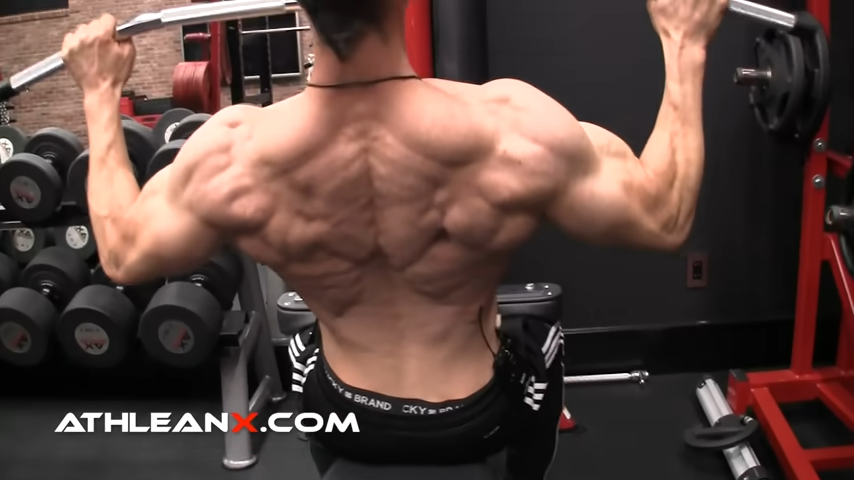
HOW TO WIDE GRIP LAT PULLDOWNS:
- First, start by adjusting the pad on the pulley cable machine. Make sure it’s snug against your thighs so you’re anchored down and can’t be lifted by the weight load.
- Reach up and grab the bar with an overhand grip wider than shoulder width. Don’t go so wide that you’re not able to get into the starting position. Listen to your body here.
- Before you begin, set your shoulder blades. Pull them down and back, almost like you’re trying to tuck them into your back pockets. This engages the muscle fibers right from the start.
- As you pull the bar down, envision driving your elbows down and back, leading the movement. Remember, it’s not about pulling the bar to you but driving those elbows. Aim to bring the bar to chest level.
WHAT MAKES IT EFFECTIVE: You’ll use the same form as the traditional Lat Pulldown but with a wider grip. This helps to target the teres major more. Just like the classic version, Wide Grip Pulldowns allow you to use heavier loads.
ROCKING PULLDOWN

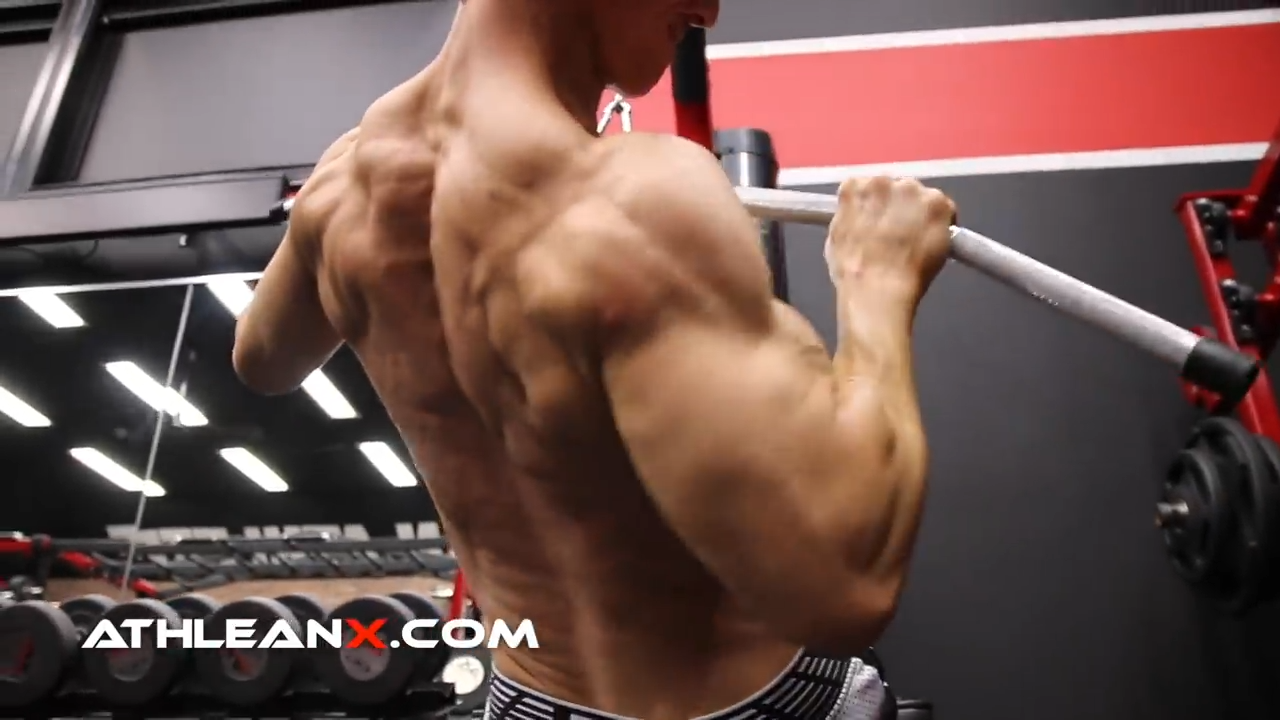
HOW TO DO WIDE GRIP LAT PULLDOWNS:
- Start by positioning yourself on the Lat Pulldown machine. Make sure your knees are securely under the pads, and you have a firm grip on the bar above you, about shoulder-width apart.
- Start the movement like a traditional Lat Pulldown. Engage your lats, pull the shoulder blades down and back, and begin pulling the bar down towards your chest. Keep those elbows driving down and slightly forward.
- Here’s where the ‘rocking’ comes into play. As you’re pulling the bar down, lean slightly to one side, really emphasizing the contraction in the lat on that side. This is where the additional adduction comes into play, getting that elbow even closer to your side.
- Return to the starting position and then repeat on the opposite side, once again focusing on that intense lat contraction.
- Continue alternating side to side until you complete all of your rep count.
WHAT MAKES IT EFFECTIVE: The Rocking Pulldown offers enhanced lat contraction through improved adduction and extension. It allows you to use heavier weight while optimizing aesthetic benefits, athletic performance, and strength gains.
SINGLE-ARM STRAIGHT ARM PUSHDOWN

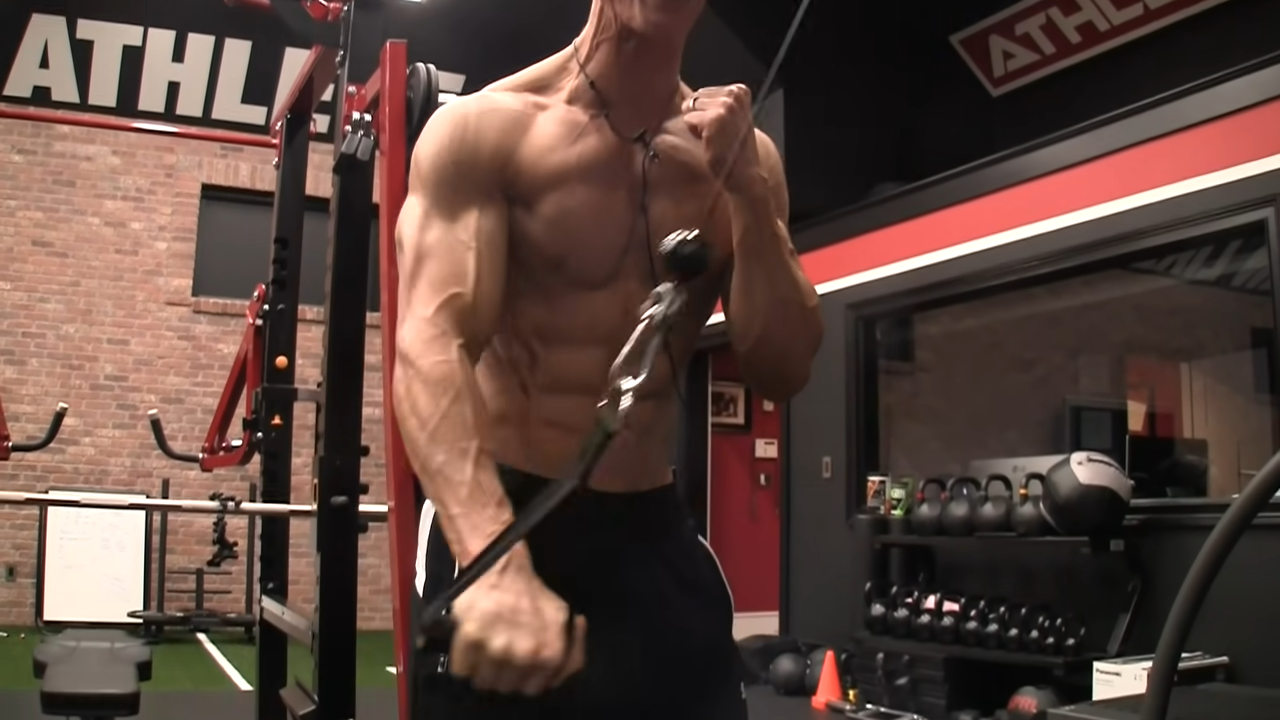
HOW TO DO SINGLE-ARM STRAIGHT ARM PUSHDOWNS:
- Start by attaching the single grip handle to the high pulley. Stand facing the machine with a staggered stance – one foot slightly forward for balance.
- Grab the handle with your right hand. Your palm should be facing down, and your arm fully extended upwards.
- Stand upright with a slight bend in your knees. Keep your chest up, shoulders down and back, and your core engaged.
- Without bending your elbow, engage your lat and push the handle downwards. Imagine you’re trying to push something behind you.
- At the bottom of the movement, squeeze your lat hard. This is where the single-arm version shines – you can really focus on that contraction.
- Slowly release the handle back to the starting position, controlling the resistance. It’s not about letting it snap back but resisting its return.
WHAT MAKES IT EFFECTIVE: While a barbell forces you to stop at your hips, single-arm pulldowns allow you to move past this point to reach full range of motion and contraction.
TRAP RAISE

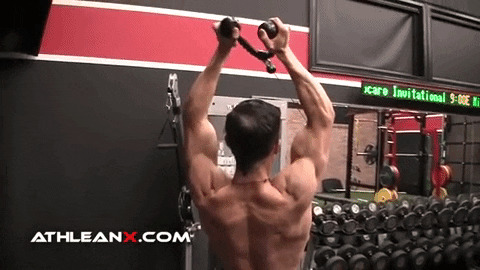
HOW TO DO TRAP RAISES:
- Grab the cable rope attachment and make sure it’s parallel to the ground. Brace your core and engage those upper back muscles. Set the cable station to use lighter weight if you’ve never done these before.
- Keeping your arms straight with a narrow grip, pull them up and back, driving them towards your body. You’re looking to move your arms from a flat position all the way to a solid 90 degrees.
- As you move the rope, you’ll keep your hands in a grip position that resembles a Hammer Curl. In other words, keep them in a neutral position.
- When you hit the top of the movement, squeeze your traps, and keep that core tight while in an upright position. Don’t lean forward; let the traps do the work!
- As you’re lifting and squeezing, always be mindful of that scapula. You want it snug against your rib cage, especially as those shoulders rotate upward. Think of it as giving you that solid foundation for a powerful isometric contraction.
WHAT MAKES IT EFFECTIVE: The Trap Raise looks like a Front Shoulder Raise, but it actually focuses on the trapezius muscles as well as the rear delts.
MAXIMIZING RESULTS OF YOUR CABLE BACK WORKOUTS
When we talk about building muscle and increasing strength gains, there are several acute variables we need to dial in on if we want to make the most out of our workouts.
Here are some of the most crucial factors to know, so you can train not just harder but smarter.
VOLUME
This refers to the total amount of work you’re doing. Think of it as the number of sets and reps combined for a given exercise or workout.
For hypertrophy (muscle growth), you generally want a moderate volume – too little won’t provide enough stimulus, but too much can push you into overtraining.
Use a weight that matches the rep count. You want to go heavy enough so you can only perform between 8 to 12 repetitions.
When using a lighter weight for your warm-up sets, you can start out by aiming for 10-12 reps. Once you start your working sets, 8-10 reps might be a better target.
INTENSITY
It’s all about the weight or resistance you’re lifting. If you’re going for muscle growth, you want to work in the range of 60% to 80% of your one-repetition max (1RM).
Again, this usually translates to a weight you can lift for about 8 to 12 reps per set.
You don’t necessarily want to use a variety of rep ranges since the science has been pretty steady with what rep range works best for hypertrophy.
TEMPO
This is the speed at which you perform each repetition. For building muscle, I’d recommend a controlled tempo that emphasizes the eccentric (or lowering) phase.
Think about a 2-0-2 tempo:
- Two seconds up
- No pause
- Two seconds down
Understandable, as you get closer to the end of your rep count, it’ll be more difficult to maintain this tempo. Do your best to last 1-2 seconds on both the concentric and eccentric portions of the lift.
If you really want to give it your all, try a 3-second count during the eccentric portion on the last rep of the set.
REST PERIODS
Don’t forget about recovery between sets. For hypertrophy, you’re looking at rest periods of around 60 to 90 seconds.
Too short, and you might not be recovered for your next set; too long, and you might lose some of the metabolic stress that contributes to muscle growth.
FREQUENCY
This is how often you train a particular muscle group. Most people find training each muscle group two to three times per week to be effective for hypertrophy, given adequate recovery.
EXERCISE SELECTION
When it comes to exercises for strength training, compound movements are foundational – they engage multiple muscle groups and allow for greater overall muscle activation.
If you only have access to cable machines, the compound exercises for the back I’d recommend would be the following:
- Lat Pulldowns
- Wide-Grip Cable Pulldowns
- Rocking Pulldowns
- Cable Row Exercise
- Wide-Grip Seated Cable Rows
- Single-Arm Rotational Pulldowns
But don’t neglect isolation exercises; they can target specific muscles that might need extra attention.
TIME UNDER TENSION (TUT)
This is the amount of time your muscles are under strain during a set. For muscle growth, keeping the muscles under tension for a longer period can be really effective.
If you’re following a 2-0-2 tempo, then you should be achieving a time under tension between 30 and 60 seconds per set.
Remember, guys, while these variables are important, they’re just one piece of the puzzle.
Nutrition, recovery, sleep, and overall lifestyle play a massive role in your fitness journey.
Train with purpose, keep these variables in mind, and as always, put the science back in balanced strength!
Excellent cable exercises are some of my favorites – need I remind you of my love for Face Pulls?
But it’s important to remember that a well-rounded program can (and should) include a mix of free weights, bodyweight exercises, and cables to maximize strength and hypertrophy gains.
The key is progressive overload, proper technique, and consistent training.
Don’t have a cable back workout for yourself? We can help with that. Check out our ATHLEAN-X programs to see which is the best fit for your goals and fitness level.

- Often overlooked but packing as much punch as barbells and dumbbells, the cable station is a piece of equipment that is perfect for a versatile back workout.
- The muscle groups to target with a cable workout include the lats, upper and lower traps, low back/erector spinae, rotator cuffs, and teres major.
- My go-to cable back exercises include the Traditional Lat Pulldowns, ROM Pulldowns, Seated Cable Rows, Straight Arm Pushdown, Alternating High Cable Row, and Face Pulls.
- If your goal is muscle growth, I’d recommend trying these exercises: Wide Grip Lat Pulldown, Rocking Pulldown, Single-Arm Straight Arm Pushdown, One-Arm Rotational Pulldown, and Trap Raise.
- To maximize your muscle mass results, perform 3-4 sets of 8-12 reps with moderate weight. Emphasize controlled 2-0-2 tempo (2s up, 0 pause, 2s down). And rest for 60 to 90 seconds between sets.
- As far as frequency, train each muscle group 2-3 times a week, focusing on compound movements but don’t neglect isolation exercises.
- Workouts with cables are great but aim for a balanced program based on your strength training goals that includes free weights, body weight, and other exercise equipment.
CABLE BACK WORKOUTS FAQS
Whether you’re performing a cable twisting exercise or a cable pullover exercise, you have plenty of options to work out your back with the cable station – a favorite piece of gym equipment.
Start with compound exercises – or the movement for strength workouts that target the most muscle fibers at one time. Normally, I’d say go with an exercise like the Bent-Over Row for the back, but if you want to use effective cable exercises, I’d recommend starting with Lat Cable Pulldowns and Seated Cable Rows.
From here, you should target the secondary muscles like the traps. Consider incorporating exercises like Alternating High Cable Rows, Face Pulls, and Trap Raises into your back workout.
Aim for two to three sets of 6 to 12 repetitions, depending on your fitness level and fitness goals.
There are several effective exercises that target the latissimus dorsi muscles and can be performed on the cable station or cable rowing machine during your workout routines.
Starting with vertical pulling movements, I’d recommend performing a straightforward cable machine exercise like the Wide Grip Lat Pulldown.
Moving over to horizontal pulling exercises, you can perform the cable row movement.
If you want to mix it up, I would suggest single-arm exercises for the lats like Single-Arm Straight Arm Pulldowns or Alternating High Cable Rows.
To train the lower back using cables, it's crucial to focus on maintaining a neutral spine and engaging the core throughout the movement.
To target the lower back, I’d recommend the Cable Deadlift exercise. Here’s how to perform Cable Deadlifts:
- Set a low pulley on a cable machine and use the straight bar attachment.
- Stand facing the machine, feet shoulder-width apart, and grip the bar.
- Push your hips back, bend your knees slightly, and lower your torso to grab the bar.
- Maintain a neutral spine, engage your core, and push through your heels.
- Stand up straight by extending your hips and knees simultaneously.
- Slowly reverse the movement to return to the starting position.
- Ensure that you keep your chest up, shoulders back, and avoid rounding the back during the movement.
Cable Rows can hit the upper back, but it all depends on the direction you’re pulling.
If you’re performing a traditional Cable Row, you’re going to target your mid-back muscles, not the upper back muscles.
However, if you pull the cable attachment in an upward direction, you’ll notice the contraction more in your upper back muscles.
With that said, if your aim is to hit your upper back, there’s a much better way to do this: Face Pulls.
Yes, you can definitely build a big, strong back using cables. Cables provide continuous tension throughout the movement, which can be beneficial for muscle growth and strength development.
Incorporate a variety of exercises such as Cable Rows, Face Pulls, Straight-Arm Pushdowns, and Cable Pullovers to target the different muscles in the back.
Building a big back goes beyond choosing the right exercises – You also need to make sure you’re performing the right acute variables.
Select three to five back exercises, ideally, one for each muscle group in the back. Perform two or three sets of 8 to 12 repetitions focusing on using between 60% to 80% of your one-repetition max (1RM). Don’t forget to give yourself a chance to rest between sets but limit it to no more than 90 seconds.
REFERENCES

Jeff Cavaliere M.S.P.T, CSCS
Jeff Cavaliere is a Physical Therapist, Strength Coach and creator of the ATHLEAN-X Training Programs and ATHLEAN-Rx Supplements. He has a Masters in Physical Therapy (MSPT) and has worked as Head Physical Therapist for the New York Mets, as well as training many elite professional athletes in Major League Baseball, NFL, MMA and professional wrestling. His programs produce “next level” achievements in muscle size, strength and performance for professional athletes and anyone looking to build a muscular athletic physique.
































